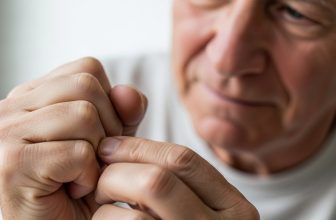
5 Powerful Ways Diabetes Awareness Can Help Prevent Dupuytren’s Fibrosis
Introduction
Diabetes affects far more than just blood sugar—it alters how the body heals, repairs, and maintains connective tissue. One lesser-known complication is Dupuytren’s contracture, a fibrotic hand disorder that leads to thickened cords and bent fingers. It occurs significantly more often in people with diabetes than in the general population. Understanding how high blood sugar and metabolic stress fuel fibrosis helps patients take proactive steps toward prevention, better management, and improved hand function.
How Diabetes Fuels Fibrosis
When blood sugar levels remain elevated over time, glucose molecules attach themselves to collagen and other structural proteins in a process known as glycation. This reaction creates advanced glycation end products (AGEs)—sticky compounds that stiffen connective tissues and prevent them from breaking down or renewing properly. These AGEs not only make tendons and fascia less flexible but also keep fibroblasts, the cells responsible for producing collagen, in a continuously activated state. The result is persistent scar-like tissue buildup, similar to what occurs in Dupuytren’s contracture.
Chronic high blood sugar also fuels inflammation and oxidative stress, both of which damage small blood vessels and impair normal healing. These same processes that contribute to diabetic complications like neuropathy, retinopathy, and kidney disease also affect the palms and fingers. Over time, these microscopic changes accumulate, leading to fibrosis that restricts hand movement and causes the classic bending of the fingers seen in Dupuytren’s.
Research Findings
Research consistently shows a strong association between diabetes and Dupuytren’s disease. Studies have found that people with long-standing diabetes are up to three times more likely to develop Dupuytren’s than those without diabetes. The risk is especially high among individuals with poor glucose control or insulin resistance. Both Type 1 and Type 2 diabetes patients are affected, but the likelihood increases with the duration of diabetes and the degree of blood sugar imbalance.
Interestingly, Dupuytren’s in diabetic patients often looks a bit different from the classic form. Instead of forming distinct cords or nodules, diabetic Dupuytren’s may appear as a diffuse thickening across the palm, sometimes progressing more slowly but affecting a broader area.
Impact on Healing and Treatment
For diabetic patients, healing after treatment—whether surgical release, collagenase injection (such as Xiaflex), or needle aponeurotomy—can take longer. Elevated glucose levels reduce blood flow to small vessels, weaken the immune response, and delay tissue repair. These factors can lead to a higher risk of infection and slower wound closure.
That’s why minimally invasive treatments like needle aponeurotomy are often preferred for people with diabetes. These techniques minimize trauma, shorten recovery time, and lower the chance of complications. Regardless of the treatment method, optimizing blood sugar levels before and after any procedure significantly improves outcomes and reduces recurrence rates.
Lifestyle Steps That Help
Managing both diabetes and Dupuytren’s requires a comprehensive lifestyle approach. Patients can take several steps to protect connective tissue health and slow fibrosis progression:
-
Keep HbA1c below 6.5–7% if safely possible, as better glucose control directly reduces the formation of AGEs.
-
Eat anti-inflammatory foods like fatty fish, leafy greens, berries, and olive oil to counteract oxidative stress.
-
Limit sugars, processed carbohydrates, and alcohol, all of which accelerate glycation and tissue stiffening.
-
Exercise daily to improve insulin sensitivity, enhance circulation, and keep the hands flexible.
-
Stay hydrated and stretch regularly to maintain soft-tissue elasticity and joint mobility.
These small daily habits can make a substantial difference in how Dupuytren’s progresses over time.
What the Science Says
Emerging research continues to reveal shared biological pathways between diabetes and fibrotic diseases. Studies published in Diabetologia and other medical journals highlight the roles of fibroblast overactivation, inflammation, and oxidative stress as common drivers. Scientists are now investigating whether therapies that block AGEs formation or modulate insulin signaling could slow or prevent Dupuytren’s development in diabetic patients. Such treatments may offer hope for more targeted and effective management in the future.
Conclusion
Managing diabetes isn’t only about protecting the heart, eyes, or kidneys—it’s also about maintaining healthy connective tissue. High blood sugar quietly fuels fibrosis throughout the body, including the hands. By keeping glucose levels steady, reducing inflammation, and adopting a proactive lifestyle, individuals can slow Dupuytren’s progression, enhance flexibility, and preserve hand function long term.
Ultimately, strong blood sugar control means stronger, healthier hands—a reminder that every step taken toward better diabetes management supports overall tissue health and well-being.
Legal & Medical Disclaimer
This content is for informational and educational purposes only and is not a substitute for professional medical advice, diagnosis, or treatment. Always consult your healthcare provider about any medical concerns or treatment options. Dupuytren’s Solutions is an educational resource meant to be used alongside, not instead of, professional care, and individual results may vary.
Call to Action
Learn more about fibrosis management and patient strategies at DupuytrensSolutions.com.
Connect with others navigating systemic fibrosis in our community: facebook.com/groups/dupuytrenssolutionsandhealth.
Attribution
(CC BY 3.0) Adapted from Wynn TA et al. Systemic Fibrosis and Connective Tissue Disorders. Fibrogenesis Tissue Repair. 2012; 5(1):14. Licensed under Creative Commons Attribution 3.0. For the complete article and reference list, click Source.






